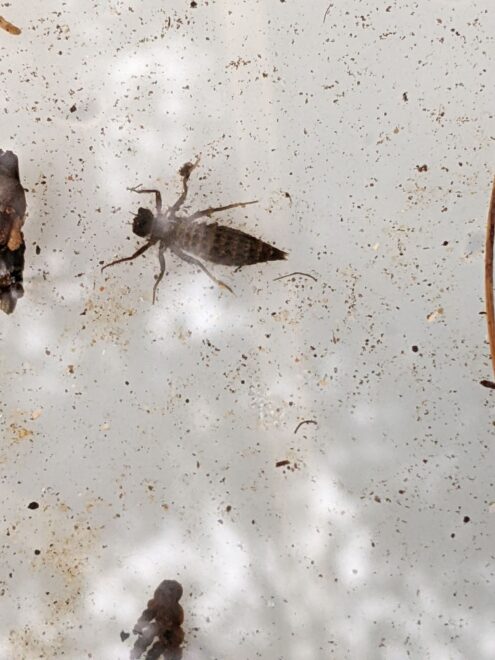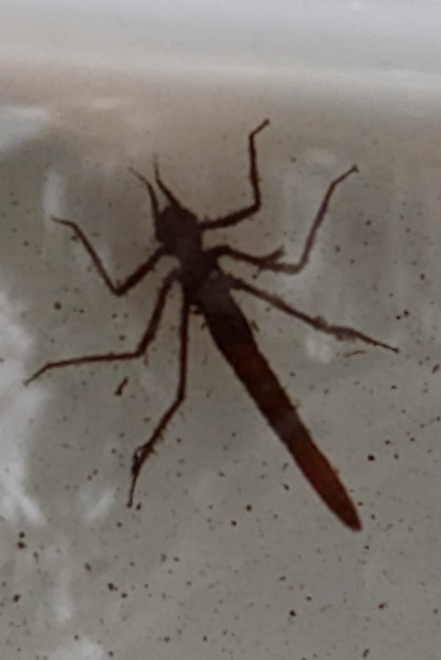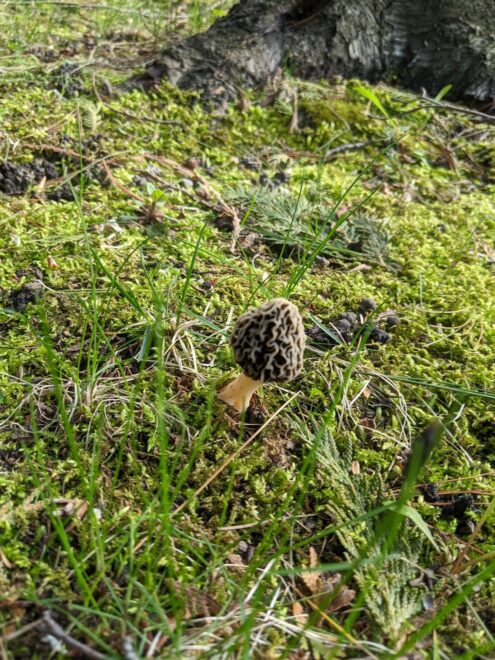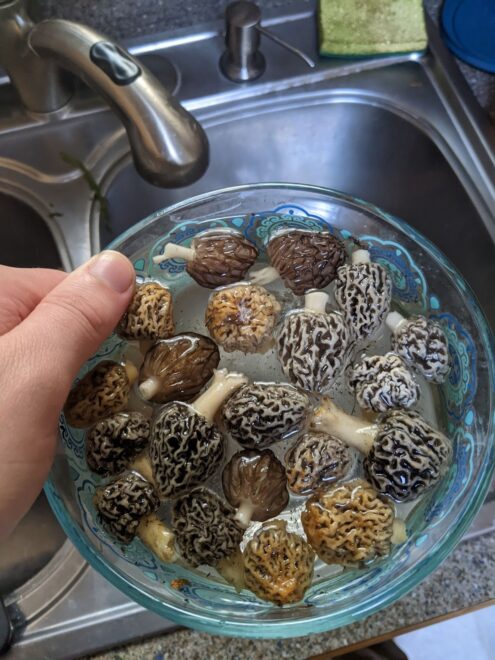Throughout this week our Great Lakes Educator, Liam, will be taking us through some natural observations that you can go out and see in your local watershed. Our observations take place around the ISEA campus, Leo Creek in Suttons Bay, and in the surrounding woods. Your results may vary depending on location. Happy Earth Week 2024!
Day 1 – Damselfly and Dragonfly
As any Benthos instructor on the ship knows, many of the insects we think of as land-based, actually spend part of their lifecycle in the water. The midge (Chironomidae) is the classic example we use on the ship, as anyone who has been out on the boat in Spring can tell you, they’re quite abundant. When at Leo Creek in Suttons Bay, MI directly off the TART trail, we can observe a whole host of other insects that spend part of their lives in the water.


These photos were taken at Leo Creek with a group of bright-minded students all the way from NYC. Pictured above, we can see a dragonfly nymph (Anisoptera) on the left and a damselfly nymph (Zygoptera) on the right. Dragonflies and damselflies are closely related; they belong to the same order, Odonata, meaning ‘toothed-one’ in Greek. As adults, dragonflies and damselflies conjure images of vivid colors, flying around with agility near swamps and wetlands in the heat of summer. Beneath those beautiful colors, however, lies a voracious predator and ruthlessly efficient hunter. Just like their adult counterparts, these dragonfly larvae are fully carnivorous and have an interesting way of catching their prey. Their lower jaw (also called a mask) is flexible and extendable and is equipped with large hooks and sharp teeth. When their prey swims past, its lower jaw will shoot out with lightning speed and skewer its meal for consumption. Their ravenous appetite means they are at the top of the aquatic food chain in most streambeds, and we found evidence of that in Leo Creek this past week. By early summer, these nymphs will emerge from the water, already able to breathe air. They will perch themselves on a plant stem or floating log and emerge into their adult forms, similar to how a butterfly emerges from a pupa. After a couple of hours, their wings will fully form and harden, and they will fly off. Keen observers can spot the leftover nymph husks still clinging to twigs.
Day 2 – The Winter Wren
Anyone who has spent any extended time with me will know that I am a big fan of birds. Springtime is a phenomenal time for birders, as Michigan lies within the migratory pathway of many of North America’s most vibrant and wonderful bird species. Many magnificent bird species that call Michigan home are returning this time of year, such as the Sandhill Crane (A. canadensis) which features its signature paleolithic-era call heard for miles, and the phenomenal Trumpeter Swan (C. buccinator), the largest waterfowl in North America. I could talk for hours about these amazing birds, but today I will be narrowing our focus to a much lesser known native bird species.
Pictured above is the Winter Wren (T. hiemalis). This very small and inconspicuous brown bird lives a rather secretive life. Sheltered in the deep thickets of forests and swamps, its behavior is described by Kenn Kaufman as behaving “more mouse than bird”. The Winter Wren prefers to hop and scamper rather than fly, where it explores through upturned trees and decaying logs in search of food. Moreover, the Winter Wren prefers to build its nest in the undergrowth thicket rather than up high in trees like most songbirds. All in all, this bird prefers to be out of sight and keep a low profile, except this time of year. In early spring, male Winter Wrens will perch high in the tree top and sing one of the most musical and complex bird songs in all of North America. Take a listen for yourself here. For such a small bird, I often wonder how the Wren’s lungs can fill with so much air to sustain this wondrous song that can last upwards of 12 seconds. Winter Wren calls can be heard all throughout Leo Creek right now. My recommendation to hear this beautiful bird call is to head out in the morning and stay as quiet as possible as you head out towards the creek.
Day 3 – Spring Wildflowers
After two blog posts about animals, both aquatic and terrestrial, I think it’s time to let the plants have their moment in the sunshine. Spring ephemeral wildflowers grow out in Northwest Michigan in high abundance and diversity. Because we’ve had a mild winter and a warm spring, many plants that usually bloom in the beginning or middle of May are starting to peek out right now. There are so many wildflowers to choose from and in the interest of keeping this blog from being a 10-page essay I’ll only talk about some of my favorites this time of year.

Dutchman’s breeches (D. cucullaria):
One of the first wildflowers to emerge after winter, Dutchman’s breeches are members of the poppy family. I took this photo over near Cedar, MI, but you can find these guys blooming in many areas in Leelanau county right now. A fun fact about Dutchman’s breeches is that it is a plant that depends on two different animal species for its proliferation. For pollination, Dutchman’s breeches need bumblebees! The outer flowers protect the plants’ stamen and pistil (the male and female part of the flower) and butterflies, flies and smaller bees are unable to reach them. Only the two-spotted bumblebee (B. bimaculatus) is strong enough to separate the outer flowers and reach the stamen and pistil. In return these bumblebees, often forging queens, get their sugary reward for a task well performed. The second species the Dutchman’s breeches are reliant on is ants! Seed dispersal by ants is a process known as myrmecochory and is observed in over 3000 plant species worldwide. During late spring the seeds begin to form as the flowers die, once summer has arrived these seeds drop to the forest floor and their starchy surface begins to turn into sugar, which attracts ants. These ants then carry the seeds away from the parent plant and lead into the ant nest where it has a rich substrate to sprout from next spring. The Haudenosaunee used this plant to create a salve made to limber and condition athletes legs and to treat skin ailments. However, Dutchman’s breeches also produce toxic alkaloid compounds and therefore should not be consumed.
Spring Beauty (C. caroliniana):
Carolina spring beauty, is a small perennial wildflower that grows no taller than 4-6 inches off the ground. Easy to walk past, yet supremely beautiful, spring beauties capture the very essence of Spring as its name suggests. Spring beauties can be found in a wide variety of areas including wetlands, parks, bluffs, ravines and even along roadsides. The flowers of spring beauties bloom for about three days, but the stamens only contain pollen for the first 24 hours, making these spring wildflowers even more ephemeral. Spring beauties are pollinated primarily by a small specialist bee aptly named the spring beauty mining bee (A. erigineae). Just like the monarch butterfly and milkweed, the spring beauty and spring beauty mining bee have coevolved together over millions of years to form a mutualistic dependence on one another. A female mining bee will pollinate several spring beauties and then return to her ground nest, where she will use the surplus pollen to craft into a small ball, upon which she lays a single egg. The egg will hatch in late summer and feed on the pollen throughout the fall and winter months, until it is ready to pupate and emerge in Spring once again. Spring beauties have been a food source for Native American tribes across North America for thousands of years. All parts of spring beauty are edible, the leaves are rich in vitamin-A and C, the roots can be eaten raw or cooked in oil, and the corms can be cooked and prepared much like potatoes.
Day 4 – Morel Mushrooms
The kingdoms of plants and animals have had their respective moments, now it’s time for the Fungi (fun guys). In true Inland Seas fashion I have to start this day off with a joke: What do you call a mushroom who makes music? A decomposer! Alright, it’s probably time I put a cap on it. No seriously, I should probably stop before I get into truffle. [The following 13 mushroom jokes have been removed by the editor for everyone’s sanity]
This time of year you bring up Spring mushrooms and there’s only one thing people want to talk about: Morels. It’s not without good reason, these mysterious mushrooms can fetch a pretty penny, up to $200 per pound of dried morels. If you find morels in a spot once, chances are you can find them again in the following years. Avid foragers will place morels in mesh bags that allow the spores from the caps to spread even after harvest, ensuring proliferation into the next season.


True Morels (Morchella sp.):
Any person on the lookout for a morsel of morels can probably tell you that there isn’t just one species of morels. In Michigan, there are three main varieties of true morels, commonly called: Grays, Blacks, and Yellows as pictured in the right photo above. They can appear from mid-April through early June. They all prefer alkaline soil conditions and seemingly pop up overnight. Morel ecology is still not well understood and it varies from species to species. What we do know is that morels are a type of mycorrhizal fungi, meaning they form symbiotic relationships with certain tree species. In a mycorrhiza, the roots of a plant interweave with the mycelium of a fungus, the fungus makes water and certain nutrients more readily available to the plant root system and in turn, the fungus receives glucose from the roots of the plant. Mycorrhizal relationships are found in about 80% of all plant species, and it’s this reliance on mycorrhiza makes morels almost impossible to farm. One common theme with morels is their abundance after wildfire. Wood ash and water mix to make the soil more alkaline which can cause morel populations to boom after a recent fire, so if you’re out looking for morels this spring, try and scout out any recently burnt woodlands (and please don’t start one yourself). Morels are a prized mushroom given their flavor and rarity. Some tips on how to prepare morel mushrooms. After you harvest them, do yourself a favor and soak them in cold water for at least 24 hours. This will give all the organisms, usually isopods but also the occasional centipede (speaking from experience here), that were living in the morel caps a reason to vacate the premises. Once you’ve soaked them and any resident critters have been evicted, you can dry them and prepare them for cooking. Please do not eat them raw. You will probably be fine, but there are cases of people getting sick from eating raw morels. I like to sautée them with minced garlic and butter for about 10 minutes on medium-low heat, season with salt and freshly-cracked black pepper. However there are a whole host of ways to cook and create meals with morels, the possibilities are truly endless.
False Morels (Gyromitra sp.):
While false morels are not technically just one species or even a single family of mushrooms, I find that the ones that look most like true morels are those of the Gyromitra family. Unfortunately and invariably these false morels end up claiming lives every year when people eat them confusing them for true morels. We are going to talk about how people can get confused between true and false morels and how to never eat a false morel. The very first thing that I will say is an old adage from my Mycology professor, “There are old mushroom foragers, and there are adventurous mushroom foragers, usually not both.” This logic will always be true, if you have any doubts about a mushroom ID, it’s very simple: do not eat it! In terms of how to tell the difference between false and true morels, the first thing that differentiates them is their appearance. True morels have a honeycomb-like appearance in their cap, whereas false morels look a lot more like brains to me. False morels also tend to have a sort of slime coat on them, whereas true morels do not have any slime or slipperiness to the touch. The true litmus test for a true morel however comes from its stem. When you pick a true morel, look up into the cap, if the stem and the cap are hollow then it is indeed a true morel. False morels on the other hand will have stems and caps full of a cotton-like substance so if it is not hollow, it’s not a true morel! I hope these tips and tricks help, but I must reiterate that you should never eat a wild mushroom if you are even a little unsure about its origin.
Day 5 – Wetlands Lightning Round
It’s hard to believe that Earth Week has come and gone so quickly. It has been such a delight to write about all these amazing organisms that live right here in Leelanau and thanks to all of you who have read any of the blogs this week. As a way to celebrate the final day of the Earth Week blogs I thought it would be fun to do a lightning round of cool happenings since there are so many I haven’t even talked about.
Case-making Caddisfly larvae (Trichoptera sp.)
Caddisflies are my all-time favorite macroinvertebrate. What at first glance often looks like a stick or a clump of sand can surprise and astonish one as it begins to move around. Caddisflies are some of the most sensitive macroinvertebrates to contaminants in the water, so finding them in a stream, as we did at Leo Creek last week, is a great sign that the water is clean and free from pollutants. Caddisflies like the one pictured above weave together their cases with silk secreted from salivary glands. Each family of case-making caddisfly has its preference on building material, but they also can use whatever material is locally available to them. Because of this, each caddisflies’ case is unique to that individual organism, which is why I believe the caddisfly is a cool guy.
Wood Frogs (L. Sylvaticus):
If you’re ever walking near wetlands in April or May and hear in the distance what sounds like a chorus of cackles, that slowly dies down as you approach and you can’t see anything or anyone, then it is likely wood frogs. The ascribed term for the wood frog’s call is “quaking”. The places where wood frogs congregate in the spring are known as vernal pools, Vernal pools are small pockets of wetlands that undergo cyclic periods of water influx during Spring and Fall with no permanent water inlet or outlet. By Summer many of these pools will have already dried up. These vernal pools are highly essential as breeding habitats for many amphibians, including frogs and salamanders. The reason they are so important is because of the absence of fish in these pools, and fish love to eat frog and salamander eggs, so vernal pools are crucial in supporting a healthy amphibian population in a local area. Wood frog armies (yes that is the correct term) will amass in high numbers, the males usually outnumbering the females 2-to-1, that’s when the chorus will begin. If you return to the vernal pool somewhat later you might find egg masses, when they are first laid they are quite small and compact but quickly absorb water and will eventually swell to the size of a softball.
Barred Owl (S. varia):
Owls have long been considered wise and spiritual beings. Afterall, the owl is the embodiment of Athena, the goddess of wisdom. It’s hard to understand why, when you look into an owl’s large and stoic eyes, you feel as though it’s looking through you more than looking at you. Michigan has four year-round native species of owl: Northern Saw-Whet (A. acadious), Eastern Screech (M. asio), Great-Horned (B. viriginanus), and Barred Owl (S. varia). Of the four, the Barred Owl is the most likely to be near water as it can often be spotted near river banks and has even been known to catch fish! I have heard Barred Owl call at Leo Creek several times, sometimes during dusk and sometimes in the middle of the day. The Barred Owl has a large variety of calls and all of them are quite unlike any other bird. The main one, locals around here call the “Who-Cooks-for-You” call. Give it a listen and see what you think:
Barred Owl mating season is in March, so the owlets of this year are about ready to take flight and leave the nest. If you’re out near the water in the early morning or late evening, keep an eye out for the majestic bird and an ear out for its menagerie of calls.
This has been a fantastic week to be outside! Thanks to everyone who tuned in, I hope in some way Earth Week has inspired you to be curious about the natural world next time you’re out on the ship, around Leo Creek or simply outdoors. Talk to you again soon!
-Liam Fries